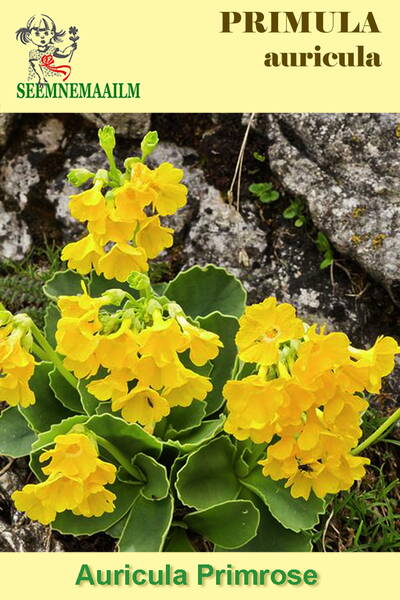A rare gem for the rock garden!
Origin: European Alps, Carpathians, and Apennines.
-
Flower colour: Golden yellow.
-
Flowering period: April – June.
-
Flower shape: Tubular.
-
Growth type: Rosette.
-
Height when in flower: Up to 15 cm.
-
Distinction: Award of Garden Merit (A.G.M.) from the Royal Horticultural Society.
Cultivation:
-
Hardiness zones: Z3-Z8.
-
Soil: Dry, well-drained, calcareous, sandy or loamy, rich in humus.
-
Use: For rock gardens (alpine gardens and rockeries).
-
Spacing between plants: 20 cm.
1.0 g = 4500 seeds.
* In the wild, it grows in Central and Southern Europe. The leaves are small, dense, leathery, grey-green, and slightly farinose on the underside. The flower stalk is up to 20 cm tall. The flowers are slightly fragrant, collected in a multi-flowered, umbel-like inflorescence. It blooms from the end of April for about 40 days. In cultivation since 1525. In cultivation, mainly derivatives of a natural hybrid with Primula hirsuta are used, known as Primula x pubescens Jacq. Cultivating auriculas in open ground presents no difficulties. Seeds are sown in March-April. They should be sown in boxes or pots—they must be kept in a greenhouse. At a temperature of +20°C, seedlings appear one week after sowing; at +16°C—after two to three weeks; at temperatures from +10 to +12°C—after one month. Germination usually spans 12-15 days. Remember that even when stored for 7-8 months, primrose seeds lose half their viability. Seedlings are pricked out. They should be planted in the ground when the leaf rosettes reach 3-4 cm in diameter. With good nutrition and sufficient moisture, auricula rosettes reach 10 cm in diameter by the first winter. By this time, the plants form a rather powerful fibrous root system and the beginnings of a rhizome. The rhizome becomes clearly noticeable only in the primrose's second year. Auriculas often flower in the second year but reach their full decorative effect only in the third or even fourth year. To quickly obtain a lot of planting material, uniform in flower colour, vegetative propagation of auriculas should be used. The ability of auriculas to produce axillary buds on the rhizome makes this task much easier. The fairly long, shallow rhizomes can be easily used for cuttings. This is done as follows: select strong, well-developed auricula specimens with several leaf rosettes. At the beginning of summer, the growth buds in the rosettes are cut out. After this, new buds quickly develop on the rhizomes. By the end of summer, with good cultivation practices, independent auricula clumps with numerous rosettes form. The following year, in mid-summer, each leaf rosette will be situated on a branch of the rhizome. These lateral rhizome branches with rosettes can be cut off and used as cuttings. The easiest and simplest method is to root these cuttings in trenches. Trenches are dug near the area where plants are grown for propagation. The trench length is arbitrary, depth—25-30 cm, width—30-40 cm. The trench is filled to a depth of 15-20 cm with sphagnum or hypnum moss. Cuttings are placed vertically in the moss so that only the leaf tips protrude above it. Large leaves should be removed. The moss must always be moist. In the first days, the leaves of the cuttings may wilt slightly; as the cuttings root, the leaves recover. Usually, up to 80% of cuttings root within a month, and 100% within a month and a half. In cold frames and boxes in a greenhouse, cuttings root more slowly than in trenches—only about 40% root after one month. Rooted cuttings are planted in a permanent place in the ground, and care is taken to ensure the soil is always well-moistened. By autumn, plants developed from cuttings are equivalent to two- and three-year-old auriculas grown from seed. If you simply need to divide and transplant an auricula, select large, well-developed plants for this purpose and take cuttings from them. Cuttings with a diameter of at least 1 cm and a length of at least 2-5 cm root better and faster. Thin cuttings do not produce buds, just as cuttings from parts of first-year rhizomes do not produce buds. In spring, primroses require good watering, but they do not tolerate waterlogged conditions, especially in winter. After flowering, they should be fed with a weak solution of manure or a small dose of complete mineral fertilizer. Auriculas are rarely damaged by diseases and pests.












